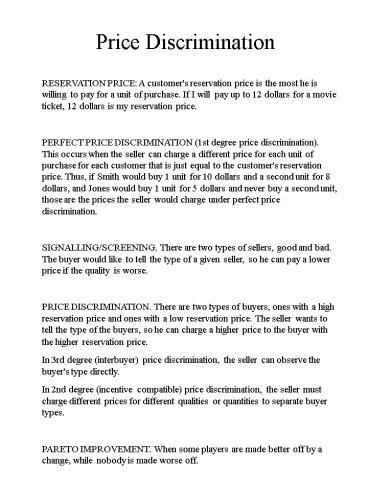Price Discrimination - PowerPoint PPT Presentation
1 / 3
Title: Price Discrimination
1
Price Discrimination
RESERVATION PRICE A customer's reservation price
is the most he is willing to pay for a unit of
purchase. If I will pay up to 12 dollars for a
movie ticket, 12 dollars is my reservation price.
PERFECT PRICE DISCRIMINATION (1st degree price
discrimination). This occurs when the seller can
charge a different price for each unit of
purchase for each customer that is just equal to
the customer's reservation price. Thus, if Smith
would buy 1 unit for 10 dollars and a second unit
for 8 dollars, and Jones would buy 1 unit for 5
dollars and never buy a second unit, those are
the prices the seller would charge under perfect
price discrimination. SIGNALLING/SCREENING.
There are two types of sellers, good and bad. The
buyer would like to tell the type of a given
seller, so he can pay a lower price if the
quality is worse. PRICE DISCRIMINATION. There
are two types of buyers, ones with a high
reservation price and ones with a low reservation
price. The seller wants to tell the type of the
buyers, so he can charge a higher price to the
buyer with the higher reservation price. In 3rd
degree (interbuyer) price discrimination, the
seller can observe the buyer's type directly. In
2nd degree (incentive compatible) price
discrimination, the seller must charge different
prices for different qualities or quantities to
separate buyer types. PARETO IMPROVEMENT. When
some players are made better off by a change,
while nobody is made worse off.
2
Crimping the Product
- Suppose 10 eager'' customers have a reservation
price of 50 for high quality and 15 for low,
while 10 slow'' customers have a reservation
price of 20 for high quality and 10 for low. We
cannot tell which customers are eager and which
are slow. Product cost is 1 regardless of
quality. - (a) If quality is low, what price should be
charged? - (b) If quality is high, what price should be
charged? - (c) If we offer two products, with low and high
quality, how much should be charged? Why wont
a price of 10 for Low and 50 for High work? - The prices of 10 and 50 wont work because they
are not incentive compatible for the Eager
customers, even though they are incentive
compatible for the Slow customers - U(slow, Low) 10-10 gt U(slow, High) 20-50
- U(slow, Low) 10-10 gt 0
- U(eager, Low) 15-10 gt U(eager, High) 50-50
NOT I.C.! - U(eager, High) 50-50 gt 0
3
Optimal Prices
- Suppose 10 eager'' customers have a reservation
price of 50 for high quality and 15 for low,
while 10 slow'' customers have a reservation
price of 20 for high quality and 10 for low. We
cannot tell which customers are eager and which
are slow. Product cost is 1 regardless of
quality. - So we have to make the High quality product more
attractive for the Eager customers to ensure
incentive compatibility. Let the High price be X.
We need - U(eager, High) 50-X gt U(eager, Low) 15-10
- U(eager, High) 50-X gt 0
- Thus, X45. At a High price of 45 and a Low
price of 10, profits are (10)(10-1) 10(45-1)
530. - This is a Pareto improvement compared to just
selling high quality. The seller and the Eager
buyers are better off, and the Slow buyers are no
worse off. - CRIMPING Even if it cost 2 per unit to crimp
the product, it would be a Pareto improvement,
because the sellers profit would be - (10)(10-3) 10(45-1) 500,
- compared to 490 from just selling High
quality at a price of 50. - Low-ability workers choose not to get diplomas.
- High-ability workers choose to get diplomas.
- Employers offer N 100 and D200.
- Payoff(High, Diploma) 200 -60 140.
- Payoff(High, No Diploma) 100 -0 100.































